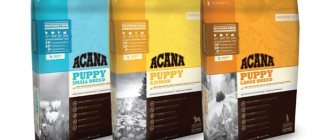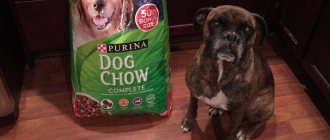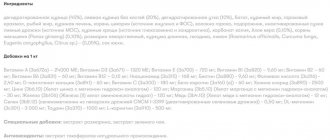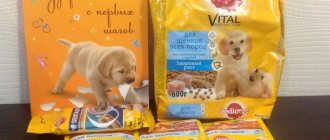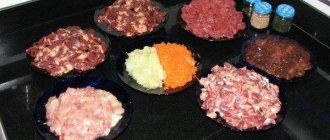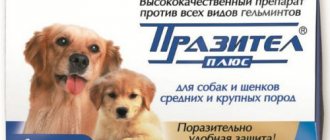The products are manufactured by the Canadian company Champion PetFoods. The popular Akana food for puppies has become one of the best dry foods for animals, satisfying all their nutritional requirements. They provide the body with vitamins and microelements, helping the pet grow healthy, strong, and full of energy.
Manufacturer and official website
Acana food is available in a wide range, but all production is “subordinated” to the brand’s philosophy. Acana has built a reputation for many years as a biological food, that is, a diet “as intended” for wild dogs. The manufacturer and official website (https://www.acana.ru/) present the food briefly, concisely and informatively. The main slogan of the brand: “Predators should eat meat.”
Each Acana diet is formulated based on your dog's weight, activity level or individual needs. One of Acana's features is WholePrey technology. In nature, a wolf or other wild dog does not eat fillets, peeled vegetables, etc. The prey is eaten whole, which is taken into account when preparing Acana diets.
Only fresh meat is used in the feed. Is it good or bad? Fresh meat is definitely better than meat and bone meal or frozen raw materials. However, during the production process, the meat dries out, loses water and decreases in volume by about 2/3. Almost all feeds, except fresh meat, use dehydrate - already dried, crushed carcasses with bones and entrails.
To preserve beneficial properties, gentle dehydration is used in the production of Acana feed - low drying temperature.
Dry dog food: how much to give, how to calculate
The daily norm is individual for each dog and depends on its weight, health, activity, etc., moreover, during the life of the animal this norm changes. Professional complete dry food is convenient not only because it includes the entire necessary set of nutrients and vitamins for a dog, but also because manufacturers always indicate on the pack the amount of dry dog food per day.
To begin with, it is important to know how much the dog weighs; if you have accurate scales at home and the dog is small, then you can weigh it at home. This is done very simply: you take the dog in your arms, step on the scales, and then subtract your weight from the resulting result. If it is impossible to perform such a procedure at home, then you can measure your dog’s weight at any veterinary clinic.
By the way, experts recommend constantly monitoring your pet’s weight; this will help regulate its nutrition, as well as prevent possible health problems.
Daily intake of dry dog food: table
Below is an example of how food calculations should look on the packaging depending on the weight and activity of the dog. Let us immediately note that if, for example, with the determination of weight everything is quite clear, then with such a parameter as activity, difficulties may arise.
Here you should focus on the following regime: if a dog walks for a total of more than an hour a day, and even more so if it lives outside in an enclosure, then such a dog is considered active and should receive the appropriate amount of food, but for a pet that spends the whole day indoors and walks for less than an hour, you need to stick to the diet for low-active dogs.
An example of recommendations for feeding adult dogs of different sizes with ready-made dry food with relatively low and high activity levels is given in this table:
| Dog weight | g/day with low activity | g/day with high activity |
| 1 kg | 20-35 | 30-40 |
| 3 kg | 45-55 | 50-70 |
| 5 kg | 75-90 | 80-120 |
| 10 kg | 175-200 | 190-240 |
| 20 kg | 220-260 | 250-300 |
| 30 kg | 280-350 | 330-400 |
| 40 kg | 380-440 | 430-500 |
| 50 kg | 450-525 | 520-590 |
| 60 kg | 520-605 | 600-670 |
| 70 kg | 580-680 | 670-770 |
| 80 kg | 650-750 | 740-850 |
How to independently adjust the daily intake of dry dog food It is important to understand that the daily intake of dry dog food indicated in the table requires individual adjustment and may vary in different foods. Therefore, it is best to check the packaging or, if for some reason you do not have it, for example, you bought the food in bulk, then go to the manufacturer’s website. It is also important to remember that the norm for puppies is very different from the norm for adult dogs.
As mentioned above, changes in the daily norm depend on several factors. An upward adjustment is possible for the following categories of cases:
- Working and active dogs that live outdoors and exercise a lot need increased nutrition. You can increase the rate at your discretion and the condition of your pet.
- A pregnant or lactating dog should receive more food, because she eats not only for herself, but also for her puppies. The daily norm can be increased by one and a half times.
- Like people, dogs can have individual metabolisms, and if the dog remains too thin at standard food rates, the portions can be increased slightly. Again, it is necessary to increase nutrition if the dog is exhausted for some reason. At the same time, it should be remembered that excessive thinness may be associated with some kind of disease, so, first of all, you need to check the dog’s health.
Downward adjustment:
- Certain breeds, such as Labradors, Rottweilers, French bulldogs and some others, are genetically prone to obesity; the weight of these dogs needs to be monitored especially carefully and if there is any upward fluctuation, the feeding rate should be reduced.
- In dogs of advanced age (from about 7–8 years old), their metabolism slows down, again they begin to move less and spend less energy; the diet of such a dog must be appropriate.
- Sometimes dogs that have undergone castration or sterilization begin to gain extra pounds, this does not always happen, but it will still not be superfluous to monitor the weight of such a pet.
Remember, it is very important how much dry food a dog eats and how much it meets the requirements of its body: excess weight, as well as exhaustion, are fraught with various diseases for the pet.
Acana food range for small breed dogs
The Acana range of food for small breed dogs consists of two diets - for adult dogs and for puppies. Both foods belong to the widest line – Acana Heritage. All foods in the line contain chicken and turkey meat, herring and flounder, and whole chicken eggs.
The Acana Heritage line of food does not contain grain. By the way, many people believe that only holistic food is grain-free, but Acana is a super-premium food.
Thanks to the similar composition, a dog can be transferred from a puppy diet to an adult diet without any fear.
Food for puppies that will weigh no more than 9 kg as adults is Acana Puppy Small Breed. For puppies of larger breeds there are separate lines: Puppy & Junior and Puppy Large Breed. For adult dogs of small breeds, the Adult Small Breed diet has been developed. Acana food for small breeds consists of 70% protein ingredients, of which approximately 60% is meat, fish and eggs!
Acana Puppy Small Breed
Acana Puppy Small Breed – food for small breed dogs aged 2 months and older. The diet is as balanced as possible:
- 70% – chicken, Pacific flounder, whole eggs.
- 30% – vegetables and fruits.
- Does not contain grains or potatoes.
Acana Puppy Small Breed is made using WholePrey technology, which means it contains by-products and cartilage. According to the manufacturer, Acana Puppy Small Breed contains a full range of vitamins and minerals necessary for the healthy growth of a puppy.
Acana Adult Small Breed
Acana Adult Small Breed – food for adult dogs weighing up to 9 kg. The diet is as balanced as possible:
- 60% – chicken, Pacific flounder, whole eggs.
- 40% – vegetables and fruits.
- Does not contain grains or potatoes.
As you can see, food for adult dogs contains 10% less protein products. However, the mass fraction of flounder is slightly increased, which meets the needs of small dogs. For small dogs, maintaining a constant weight is extremely important. If fed incorrectly, in the cold season, the dog quickly loses weight. If the balance of proteins and carbohydrates in the diet is disturbed, fat mass quickly gains.
Why is this so important?
In this regard, dogs are just like people. So, a lack of proteins, fats and carbohydrates can lead to a general weakening of the body. This is especially dangerous for puppies, whose bodies are still developing.
If you do not follow the rules of dry dog food and give it too much, your pet will easily become fat, which can also result in various diseases, primarily related to the cardiovascular system.
In this case, the optimal option can be considered the option of creating a strict nutrition schedule and feeding dosages, especially since dry food has a balanced composition and is quite simply divided into optimal portions.
Composition of Acana feed
Let's look at the composition of Acana food for small breeds using the example of the daily diet for adult Small Breed dogs. The food is available in three packages:
- 340 g
- 2 kg.
- 6 kg.
Different packaging is especially convenient if you decide to switch your dog from natural feeding or other food. Compound:
- Fresh chicken fillet (12%) is a source of protein.
- Dehydrated chicken (12%) and turkey (12%) - flour made from meat, bones, cartilage and offal.
- Red lentils, green peas, green beans are nutritious, healthy and low-calorie sources of plant proteins.
- Chicken fat (5%), fresh chicken by-products (4%) are a source of fatty amino acids, vitamins, minerals, and proteins.
- Dehydrated Atlantic herring meat (4%) – meal from meat, bones, cartilage and offal, a source of proteins and minerals.
- Fresh whole eggs (4%) are a source of proteins, microelements and fats.
- Fresh whole flounder (4%) is a healthy fish with relatively low fat content.
- Herring oil (2%) is a very rich source of vitamins, amino acids and microelements.
- Sun-dried alfalfa (2%), green lentils (2%), yellow peas, pea fiber - a source of rough fiber, minerals, vitamins, carbohydrates and vegetable proteins.
- Fresh chicken cartilage (1%) is a source of glucosamine and chondroitin, which is extremely important for the proper formation and function of joints.
- Brown algae, table and butternut squash, parsnips, kale, spinach, mustard leaves, turnip greens, carrots, apples, and pear varieties are sources of vitamins, microelements and coarse fiber.
- Freeze-dried chicken and turkey liver is a source of essential amino acids.
- Cranberries, Blueberries, chicory root, turmeric, milk thistle, burdock root, lavender flowers, marshmallow root, rose hips are sources of vitamins and amino acids.
- Enterococcus faecium is a basic probiotic.
Guaranteed performance:
- Protein 31% – excellent, the level of holistic food.
- Carbohydrates 28% are normal.
- Fat 17% is normal, the level of holistic food.
- Fiber 5% is a little higher than normal, but it's good.
- Humidity 12% is slightly higher than normal, which makes the feed heavier.
- Calorie content – 351 kcal per 100 g – an excellent indicator.
Please note that the calorie content “consists” of 31% proteins, 28% plant foods, 41% fats - this is one of the most optimal balances. The food contains glucosamine (1400 mg/kg) - this is a very good indicator that guarantees the normal functioning of the joints.
Acana food dosage for puppies
Diet standards depend on the age, level of activity and weight of the pet. The Akana food feeding chart for puppies describes the daily feeding requirements for babies. The dosage should be distributed over several doses:
- from 1.5 to 2 months, feed 6 times a day;
- from 2 to 3 months the number of approaches is reduced to 5 times a day;
- at 4-5 months of age, feeding is done 4 times a day;
- after six months - three times a day;
- Adults (from one year of age) eat twice – morning and evening.
| Acana puppy food feeding chart | |||||
| baby's weight | weight of an adult, kg. | ||||
| 5 | 10 | 20 | 30 | 40 | |
| 1 kg. | 40 g. | 40 g. | 40 g. | 40 g. | 40 g. |
| 2 kg. | 80 | 80 | 80 | 80 | 80 |
| 5 kg. | 80* | 130 g. | 160 g. | 180 g | 180 g |
| 10 kg. | 160 g.* | 210 g. | 300 g. | 300 g. | |
| 20 kg. | 250 g.* | 400 g. | 400 g. | ||
| 30 kg. | 330 g.* | 540 g | |||
| * a grown pet switches to a diet for mature dogs | |||||
Acana for puppies helps young dogs of any size develop a healthy body, achieve better coat condition, musculoskeletal system, and become vigorous and healthy. The food does not contain flavor enhancers or flavorings and is based on fresh products. Natural ingredients form the natural taste of the products, which are loved by four-legged friends around the world.
Advantages and disadvantages of feed
Having analyzed the composition, we can identify the main advantages and disadvantages of Acana feed.
Let's start with the advantages:
- The food is truly balanced and meets the biological needs of small dogs.
- Does not contain wheat, corn or other grains.
- The majority of proteins are of animal origin.
- The food contains by-products and cartilage, but in small quantities.
- Optimal calorie content.
- The composition of the food is similar for puppies and adult dogs.
- The composition contains the percentage of key ingredients.
- Does not contain dyes, artificial preservatives, or flavor enhancers.
The only disadvantage of Acana food is the cost. Acana has equivalents with guaranteed performance at a reduced cost. However, if you study the composition of analogues, you will find cereals.
Individual approach
When deciding how much dry food to give a puppy per day, take into account its individual characteristics and living conditions. During the winter season, animals that live or spend a lot of time outside spend more energy on warming up, so their daily dosage can be increased.
If your pet is not gaining weight well on a diet calculated according to all the rules, then after consulting with a veterinarian, the amount of food can be increased. And when the increase, on the contrary, is too large, you should stick to the lower limit of the norm. Otherwise, the puppy is at risk of obesity, problems with the spine and joints due to excessive stress on the fragile skeleton.
Puppy feeding diet
The first six months of a dog’s life are accompanied by the most rapid changes in their body proportions: it is during this time that the musculoskeletal system is formed, teeth grow and change. If a puppy receives an incorrect diet during such a crucial period, it is almost impossible to compensate for this in the future: a lack of nutrients can lead to the development of rickets, pathologies of the joint-ligamentous apparatus, for example, malocclusion or ear positioning, and coat defects.
After 6 months, the puppy no longer grows as rapidly, but still needs high-quality nutrition appropriate for its age.
What to feed: a puppy’s diet in a new home
The food needs of growing animals are higher than those of adult animals: not only more calories are required, but also more “building materials” for organs and tissues. Ready-made complete food for pets already contains all the nutrients the body needs in the optimal ratio. The main thing is to choose a product with a good composition and adhere to the dosages recommended by the manufacturer. Creating a puppy’s feeding diet from natural products on your own is not an easy task and requires much more time.
Whatever you decide on, you should have an understanding of the basic principles of feeding carnivores, which of course includes our domestic dogs, as well as the individual nutritional needs of puppies.
Protein is the main building material for the body
The younger the animal, the more intensively it grows, and therefore, it requires more proteins to build organs and tissues. A lack of this important macronutrient can result in developmental and growth disorders, decreased immune defense, and deterioration of the skin and coat.
Experts are not always unanimous, but on average they recommend at least 9-10 grams of protein per kg of body weight per day for puppies and young animals. As the dog gets older, this need gradually decreases and by the age of one year it is 4–6 grams.
